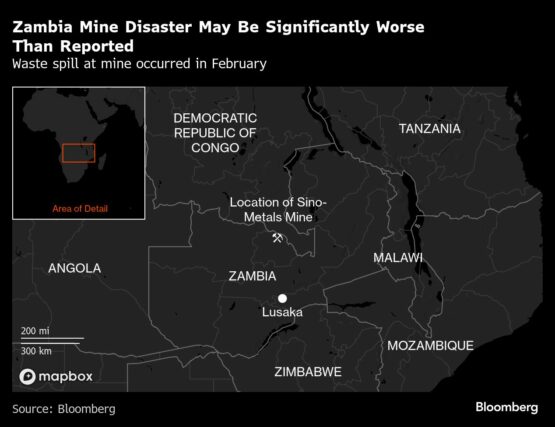Toxic Spill at Chinese-Owned Zambian Mine Found to Be 30 Times More Severe Than Initially Estimated
An independent evaluation has revealed that the partial collapse of a waste dam at a Chinese state-owned copper mine in Zambia may have released 30 times more toxic sludge into the environment than initially reported.
Approximately 1.5 million tons of this hazardous material escaped when a reservoir at the Sino-Metals Leach Zambia mine near Kitwe failed, as per findings from the company tasked with assessing the environmental damage. This volume could fill over 400 Olympic-sized swimming pools and would classify the incident among the mining industry’s most severe disasters worldwide.
ADVERTISEMENT
CONTINUE READING BELOW
The government and the mining company had previously stated that 50,000 tons were spilled during the February incident. However, evidence from social media and site assessments indicates this figure is “grossly inaccurate,” as Drizit Zambia, hired by Sino-Metals for an environmental audit, noted in a letter dated June 3, which has been reviewed by Bloomberg.
Drizit characterized the event as a “large-scale environmental catastrophe” that poses a risk to drinking water, local fisheries, and agriculture. Sino-Metals, which has ended its contract with Drizit, has called into question the methods used to gauge the amount of the spill.
This disaster jeopardizes Zambian President Hakainde Hichilema’s strategy to significantly increase copper production to 3 million tons in the next few years. In 2023, China Nonferrous Mining Corp., the parent company of SML, committed to investing $1.3 billion to boost output in Zambia, the continent’s second-largest copper producer.
Additionally, the incident complicates Lusaka’s relationship with Beijing, particularly as Hichilema’s administration is aiming to finalize restructuring negotiations concerning about $5.6 billion of debt owed to Chinese lenders.
US concern
Last week, the US Embassy expressed concern over the scale of the disaster, prompting it to direct the immediate withdrawal of its personnel from Kitwe and surrounding regions due to newly uncovered information regarding the extent of contamination.
In an Aug. 6 email to staff seen by Bloomberg, US Ambassador to Zambia Michael Gonzales remarked that the disaster seems to be the sixth worst in recorded history, warning that toxic substances such as arsenic, cyanide, and uranium will continue to pose risks to human and animal health until removed.
The US Embassy declined to provide any further comments.

Drizit cautioned that without immediate action, the repercussions for future generations of Zambians could be severe and enduring, as stated in their letter.
While the company confirmed the authenticity of the letter, it refrained from further comment citing legal restrictions. Drizit’s parent company, operating in South Africa, has been involved in environmental risk mitigation since 1975.
Sino-Metals explained the termination of the contract was due to unspecified breaches and claimed Drizit had the opportunity to address these issues but failed to do so.
A spokesperson for the company mentioned, “The dam from which the tailings escaped remains intact, and the volume of the spill can be determined by the dam’s capacity. However, if Drizit managed to quantify the spillage based on social media footage, that’s an intriguing method.”
Zambia’s green economy and environment minister, Mike Mposha, opted not to comment immediately.
ADVERTISEMENT:
CONTINUE READING BELOW
Drinking water
The Zambian government downplayed concerns regarding the incident, asserting that there was no need for panic and claiming that water quality in the affected areas has been restored. Senior officials were seen on state media over the weekend consuming tap water from Kitwe as proof of its safety.
No fatalities or confirmed instances of heavy metal poisoning has been reported, according to government statements.
The mishap occurred when heavy rainfall on February 18 caused a dam wall to rupture, releasing a flood of sulphuric acid-laden material into the nearby Mwambashi River.
Initial assessments indicated that the river’s pH level plummeted to as low as 1, as informed by Collins Nzovu, Zambia’s water and sanitation minister, to lawmakers on February 21. Such acidic fluid is powerful enough to dissolve human bones.
The Mwambashi River feeds into the Kafue River, which traverses one of Africa’s largest national parks. The capital city, Lusaka, depends on this river for a significant portion of its water supply.
In the immediate aftermath, the government initiated the dispersal of hundreds of tons of lime into the rivers to neutralize the acid, which had devastated aquatic life and crops for miles around.
While acidity levels may have normalized, heavy metals remain a significant danger, particularly for the 800 individuals still residing near the fallout zone, as mentioned in Drizit’s letter.
The company noted that its relation with SML has been challenging.
“From the beginning, they have actively attempted to obstruct the assessment process and have made efforts to influence our findings,” Drizit stated. “SML accused us of contract violations and subsequently terminated the agreement just days before its conclusion, seemingly to prevent our report from reaching the relevant authorities.”
© 2025 Bloomberg
Follow Moneyweb’s comprehensive finance and business news on WhatsApp here.

